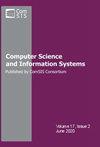A framework for fake news detection based on the wisdom of crowds and the ensemble learning model
IF 1.2
4区 计算机科学
Q4 COMPUTER SCIENCE, INFORMATION SYSTEMS
引用次数: 1
Abstract
Nowadays, the rapid development of social networks has led to the proliferation of social news. However, the spreading of fake news is a critical issue. Fake news is news written to intentionally misinform or deceive readers. News on social networks is short and lacks context. This makes it difficult for detecting fake news based on shared content. In this paper, we propose an ensemble classification model to detect fake news based on exploiting the wisdom of crowds. The social interactions and the user?s credibility are mined to automatically detect fake news on Twitter without considering news content. The proposed method extracts the features from a Twitter dataset and then a voting ensemble classifier comprising three classifiers namely, Support Vector Machine (SVM), Naive Bayes, and Softmax is used to classify news into two categories which are fake and real news. The experiments on real datasets achieved the highest F1 score of 78.8% which was better than the baseline by 6.8%. The proposed method significantly improved the accuracy of fake news detection in comparison to other methods.基于群体智慧和集成学习模型的假新闻检测框架
如今,社交网络的快速发展导致了社会新闻的激增。然而,假新闻的传播是一个关键问题。假新闻是故意误导或欺骗读者的新闻。社交网络上的新闻很短,缺乏背景。这使得基于共享内容的假新闻很难被发现。在本文中,我们提出了一个基于群体智慧的集成分类模型来检测假新闻。社交互动和用户?在不考虑新闻内容的情况下,自动检测Twitter上的假新闻。该方法从Twitter数据集中提取特征,然后使用支持向量机(SVM)、朴素贝叶斯(Naive Bayes)和Softmax三个分类器组成的投票集成分类器将新闻分为假新闻和真新闻两类。在真实数据集上的实验获得了最高的F1分数78.8%,比基线提高了6.8%。与其他方法相比,该方法显著提高了假新闻检测的准确率。
本文章由计算机程序翻译,如有差异,请以英文原文为准。
求助全文
约1分钟内获得全文
求助全文
来源期刊

Computer Science and Information Systems
COMPUTER SCIENCE, INFORMATION SYSTEMS-COMPUTER SCIENCE, SOFTWARE ENGINEERING
CiteScore
2.30
自引率
21.40%
发文量
76
审稿时长
7.5 months
期刊介绍:
About the journal
Home page
Contact information
Aims and scope
Indexing information
Editorial policies
ComSIS consortium
Journal boards
Managing board
For authors
Information for contributors
Paper submission
Article submission through OJS
Copyright transfer form
Download section
For readers
Forthcoming articles
Current issue
Archive
Subscription
For reviewers
View and review submissions
News
Journal''s Facebook page
Call for special issue
New issue notification
Aims and scope
Computer Science and Information Systems (ComSIS) is an international refereed journal, published in Serbia. The objective of ComSIS is to communicate important research and development results in the areas of computer science, software engineering, and information systems.
 求助内容:
求助内容: 应助结果提醒方式:
应助结果提醒方式:


